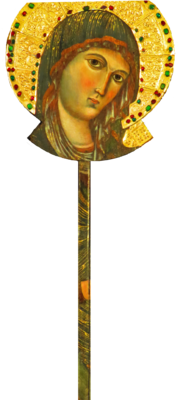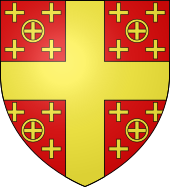Philip of Courtenay
Philip of Courtenay (* 1240/41 in Constantinople ; † December 15 or 25, 1283 ) was the son of Emperor Baldwin II from the House of Courtenay and Maria von Brienne, their heir in the Latin Empire of Constantinople . Although the imperial family lived in exile after the loss of Constantinople in 1261, Philip assumed the dignity of emperor after the death of his father in 1274, thus establishing the line of so-called titular emperors .
Life
In the spring of 1248 his father pledged Philipp for an undisclosed sum to a Venetian merchant family, to whose mother city he was taken, where he spent the years of his youth. From there he addressed a letter to King Ludwig IX on June 10, 1259 . of France , to whom he thanked for its ultimately unsuccessful effort to buy his ransom. It was only thanks to the financial generosity of King Alfonso X of Castile that Philip was released again by 1261 at the latest, because on May 1, 1261, alongside the kings of France and Navarre in Beauvais, he was a documented witness of the carpentry collection of the relics of Saint Julian, the was a companion of also Saint Lucianus , the founder of the diocese of Beauvais . On July 6, 1262 Philip stepped in Clermont-Ferrand as a documentary witness for King James I of Aragon and in 1263 he sold eventually representing his family all rights to the earldom of Namur which since 1259 by the Count of Luxembourg , Henry V occupied was, the Count of Flanders for 20,000 Paris pounds.
As early as July 25, 1261, Constantinople was recaptured by the Byzantines under Michael VIII. Palaiologus and Philip's father, Baldwin II, was forced into exile in the Kingdom of Sicily , where he joined his family in France in 1263 . Baldwin II had initially linked hopes of a return to Constantinople with the military support of King Manfred of Sicily , which however fell out of favor with the Curia of Rome , which had disempowered the Sicilian Staufer king . Apparently, this background stems from Pope Clement IV's refusal on March 31, 1266 for his dispensation to marry Philip and a daughter of the King of Castile , Alfonso X the Wise , which was probably arranged as a result of his ransom. Instead, on May 27, 1267 in Viterbo , Philip was betrothed to Beatrix , a daughter of Charles of Anjou , who had conquered the Kingdom of Sicily the previous year and killed King Manfred on February 26, 1266 in the battle of Benevento . In the Viterbo Agreement (May 27, 1267), Baldwin II, under the leadership of the Pope, linked his and his family's fate with the interests of Charles of Anjou, who had promised the return of the imperial family to Constantinople. The wedding was to take place on October 15, 1273 in Foggia . On February 9, 1269, Charles transferred 600 ounces , the income of Alisi, Galena and Rocca di Mandragora , to his future son-in-law Philip . In addition, father and son often had to do with their French estates ( Courteney ), as they were temporarily in feud with Count Heinrich of Luxembourg and lived mainly on the pensions that Karl paid them out.

After the death of Baldwin II, Philip assumed the imperial title, which he held until his death on December 15, 1283. In January 1274, Philip was first mentioned in a certificate from Charles of Anjou as "domino Philippo Imperatori Constantinopolitano" and in November of the same year as "Philippe Dei gratiâ nunc Constantinopolitane imperator illustris" on the occasion of the confirmation of the Viterbo Agreement as emperor. On March 10, 1275 he finally appeared in Brindisi as "Philippus, Dei gratiâ fidelissimus in Christo imperator, Romaniæ que moderator, et semper Augustus".
Although Philip was recognized by the Latin princes who remained in Romania after 1261 , most of his reputation was based on his association with Charles of Anjou. On March 10, 1274, Philip gave the Kingdom of Thessaloniki to his brother-in-law, Philip of Anjou, in order to please his father-in-law, Charles of Anjou. On July 3, 1281, Charles of Anjou forged an alliance with Venice in Orvieto in order to prepare a large-scale campaign against Constantinople. The plans of Charles and thus the importance of Philip came to an abrupt end in March 1282 with the outbreak of the Sicilian Vespers .
After his father's death, Philip inherited the head of the great Hodegetria icon, which his father is said to have taken with him on his flight from Constantinople in 1261. Owning the Hodegetria was very important at the time. It meant the true palladium of Constantinople and meant securing its protection and the hope of a return to the city that was so close to our hearts. After Philip's death on December 15 or 25, 1283, the icon passed into the possession of his only daughter Catherine de Courtenay (* 1275; † 1307/08).
family
His daughter Katherina von Courtenay (* 1275; † 1307/08) emerged from his marriage to Beatrix von Anjou , who married the French prince Karl von Valois (* 1270; † 1325) in 1301 .
Beatrix died in November / December 1275. Philip agreed on a new marriage project with King Alfonso X of Castile by intending to marry his daughter Berengaria († 1284). This is from a letter from King Peter III. of Aragón from August 1, 1281 to the King of Castile, to whom he expressed his displeasure with this dynastic union, since Castile would have allied itself with the enemies of Aragon. Ultimately, the Castilian marriage was not realized until Philip's death. Philipp lived with his daughter Katharina in the Palazzo Capuano in Portici , Naples, and Karl von Anjou regularly paid him an annual pension of 2,000 ounces and supplied the necessary grain for his court.
literature
- Peter Lock: The Franks in the Aegean 1204-1500. New York 1995.
- Robert Lee Wolff: Mortgage and Redemption of an Emperor's Son. Castile and the Latin Empire of Constantinople . In: Speculum , 29 (1954) 45-84.
Web links
- Filippo di Courtenay, imperatore titolare di Costantinopoli. In: Treccani.it. Retrieved August 30, 2017 (Italian).
Individual evidence
- ^ F. Schlumberger: Sceaux et bulles des empereurs latins de Constantinople (1890), p. 22.
- ↑ Marino Sanudo , Secreta Fidelium Crucis , ed. by Jacques Bongars in: Gesta Dei Per Francos , Vol. 2 (1611), p. 73; Istoria del Regno de Romania . Edited by Charles Hopf: Chroniques Gréco-Romanes (1873), p. 115 f .; Fragmentum , ed. ibid., p. 171 ff.
- ↑ Wolff, p. 49.
- ↑ P. Louvet: Histoire et antiquitez du pais de Beauvaisis . Vol. 1 (1631), p. 415 f.
- ↑ R. Berger: Layettes du trésor des Chartes . Vol. 4 (1902), No. 4775, p. 42 f.
- ↑ Alphonse Wauters: Table chronologique des chartes et diplomes imprimés concernant l'histoire de Belgique . Vol. 5 (1876), pp. 285 f.
- ↑ Wolff, p. 69 f. For refused dispensation see: E. Martène, U. Durand: Thesaurus novus anecdotorum . Vol. 2 (1717), No. CCLVIII, Col. 303 f.
- ↑ Elie Berger: Layettes du trésor des Chartes . Vol. 4 (1902), No. 5284, pp. 220-224; Del Giudice, G .: Codice diplomatico del regno di Carlo I. e II. D'Angiò . Vol. 2/1 (1869), No. IV, pp. 30-44.
- ↑ a b c d General Encyclopedia of Sciences and Arts . First Section AG. Hermann Brockhaus, Leipzig 1867, p. 263 ( full text in Google Book Search).
- ^ Ignazio Ciampi: Cronache e statuti della città di Viterbo . Cellini e Co., Florence 1872, p. 370 (Italian, online version in Google Book Search).
- ^ G. Del Giudice: Codice diplomatico del regno di Carlo I. e II. D'Angiò . Vol. 2/1 (1869), p. 41 f., Note 5, no. 6; Histoire de l'empire de Constantinople;… par Du Fresne du Cange . Vol. 2, ed. by Jean Alexandre Buchon (1826), No. II, p. 323 ff.
- ↑ Histoire de l'empire de Costantinople;… par Du Fresne du Cange . Vol. 2, ed. by Jean Alexandre Buchon (1826), No. IV, p. 325.
- ↑ Michele Scaringella: La Madonna Odigitria o Maria Santissima di Costantinopoli e San Nicola venerati a Bari. (PDF) p. 6 , accessed on August 30, 2017 (Italian).
- ^ Margherita Guarducci: La più antica icone di Maria, un prodigioso vincolo tra Oriente e Occidente . Istituto Poligrafico e Zecca Dello Stato, Rome 1989, p. 68 (Italian).
- ↑ Cf. Wolff, p. 74, note 71. The discrepancy in the date of death is due to a different editing of the underlying medieval source in historical research of the 19th century. The original document, along with most of the Angevin archive, was destroyed during the uprising against the German occupation in September 1943 and can no longer be checked. See Wolff, p. 73, note 67.
- ↑ PP. Benedettini di Montevergine: Montevergine: guida-cenni storici . Desclée, Lefebvre e C. Editori, Rome 1905, p. 54 (Italian, Textarchiv - Internet Archive ).
- ^ C. Minieri Riccio: Genealogia di Carlo I. di Angiò: prima generazione . (1857), p. 116, note 257.
- ↑ Memoiral Histórico Español . Vol. 2 (1851), No. CXCI, pp. 49 f. In addition to Berengaria's marriage to Philip, the Castilian king also planned a marriage between his son Sancho and a daughter of Charles of Anjou. The King of Aragón, who claimed the inheritance of the Hohenstaufen, became an enemy of the Angevin .
- ↑ General Encyclopedia of Sciences and Arts . First Section AG. Hermann Brockhaus, Leipzig 1867, p. 263 ( full text in Google Book Search).
| personal data | |
|---|---|
| SURNAME | Courtenay, Philipp von |
| ALTERNATIVE NAMES | Courtenay, Philippe Ier de |
| BRIEF DESCRIPTION | Titular Emperor of Constantinople |
| DATE OF BIRTH | 1240 or 1241 |
| PLACE OF BIRTH | Constantinople |
| DATE OF DEATH | December 15, 1283 or December 25, 1283 |
| Place of death | Viterbo |


